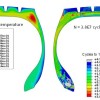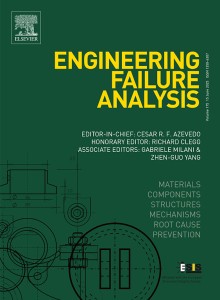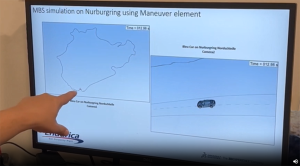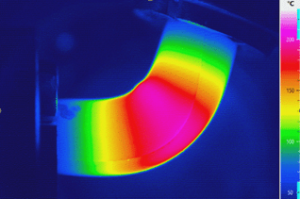
The relationship between crack nucleation and fracture mechanics experiments for polymers was first documented in 1964 by Gent, Lindley and Thomas (Journal of Applied Polymer Science, 8, 455, 1964.)
Some weeks ago, I attended the WCX 2017 SAE World Congress and Exhibition, where a Technical Expert Panel Discussion on the topic of Durability Analysis in CAE was held. The panel was moderated by Yung-Li Lee (FCA US LLC), and included topic experts Abolhassan Khosrovaneh (General Motors LLC), Xuming Su (Ford Motor Co., Ltd.), and Efthimio Duni (FCA EMEA). The discussion was excellent and wide ranging, owing both to the panelists, and also to the audience, which (judging by the high engagement) was very well versed with the core of the topic, as well as its frontiers. I will not attempt to give a complete summary of the event, but I do want to highlight a memorable discussion thread, and to offer a few thoughts.
I do not know who raised the topic. It could have been a doctoral student or young professional. Clearly, it was a person wanting to align his own efforts well relative to larger industry trends. He started out with the observation that the classical crack nucleation methods (in which fatigue behavior is defined by a stress-life or strain-life curve) are quite popular in the automotive sector for analyzing fatigue of metals. He also observed that modern tools for rubber take a different approach based upon a fracture mechanics method (in which fatigue behavior is defined by a crack growth rate curve). He then asked (I’m paraphrasing from memory here):
- Which method (nucleation vs. fracture mechanics) is preferred for analysis of polymers?
- Should we try to unify all testing and analysis efforts for metals and polymers under the same method?
The panelists made several points in responding to this prompt. They started with the point that differences in methodology may be hard to avoid, if only because metals and polymers are so different in composition, molecular structure, and microstructure. Of course, it is possible to use fracture mechanical methods with metals, although there are some limitations implied by the granular crystalline structure of metals when cracks are very small. Likewise, it is also possible to use stress-life methods with polymers, although certain aspects of the material behavior may be incompatible with the usual procedures, leading to questionable results. From a practical standpoint, it would be quite difficult to change the methods used by the industry for metal fatigue analysis – the methods are quite mature at this point, and they have been implemented and validated across so many codes and projects that it is hard to imagine what could be gained by making a change. For polymers, CAE durability methods are newer, and we should use what works.
There is a final point that I believe will ultimately define how this all plays out. It is that 1) fatigue analysis for polymers is usually driven by multiple “special effects”, and that 2) the economics of the testing required to characterize these effects scales very differently between the two approaches.
Let me illustrate with a typical example: we have a Natural Rubber compound used in a high temperature application, for an extended time, under nonrelaxing loads. Let’s compare our options:
| Option 1
Stress-Life Method |
Option 2
Fracture Mechanics + Critical Plane Method |
| To use the stress-life method, we will need to develop curves that give the effect of 4 parameters on the fatigue life: 1) strain amplitude, 2) mean strain, 3) temperature, and 4) ageing. The experiment is a simple cycle-until-rupture procedure, with one test specimen consumed per operating condition tested.
Let’s assume that we measure each of the four parameters at only 3 levels, and that we will require 3 replicates of each experiment. The total number of fatigue experiments we need is therefore:
N = 3 amplitudes x 3 means x 3 temperatures x 3 ageing conditions x 3 replicates = 35 = 243 fatigue to failure tests
|
With the fracture mechanics method, a single run of the experiment solicits the crack at many different operating conditions, enabling observation of the crack growth rate at each condition. Using Endurica’s standard testing modules, the example testing program (including replication) would require the following procedures:
Core module: 9 experiments (amplitude effect) Nonrelaxing module: 3 experiments (mean effect) Thermal module: 12 experiments (temperature effect) Ageing module: 30 experiments (ageing effect)
|
| 243 tests required | 54 tests required |
In this example, the fracture mechanics method is almost 243/54 = 4.5x more efficient than the stress-life method! If you need more than 3 levels, or if you have more than 4 key operating parameters, the experimental cost for the stress-life method quickly becomes completely impractical, relative to the fracture mechanics method. Based on these scaling rules, and on the fact that polymers exhibit so many special effects, you can now appreciate why the fracture mechanics method must prevail for polymers. For metals, the case is less compelling: there aren’t as so many special effects, and the industry testing norms are already well established.
Bottom line: for fatigue of polymers, the economics of testing for ‘special effects’ strongly favors a fracture mechanics approach. This fact is certain to shape the future development of fatigue life prediction methods for polymers.







